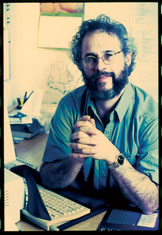|
|
Guiding the Blind |
March 2004 |
|
In many cultures, music making is a widely recognized form of employment for the blind. I don't imagine that blind people are any more musically talented than sighted people, but because their other options have traditionally been more limited, those who had musical talent have more often been encouraged. Today, the rise of computer technology and the personal recording studio appears to be a double-edged sword for blind musicians. On the one hand, computer technology and the Internet offer the possibility of increased independence. On the other hand, most music software relies on a graphical user interface, and if you can't see the screen, navigating a GUI can be a nightmare.
The good news is that on the Windows platform, there are at least two good screen-reading programs. Among other things, these screen readers use a speech synthesizer to "speak" onscreen text in any standard Windows application, providing blind people with much more access. At least some Windows music applications can use screen readers to make their products more accessible to blind users.
The bad news is that no comparable screen reader has been released for Mac OS X. And even where basic enabling technologies for the blind exist, few music-software developers are actively pursuing it. That could and should change.
Let's start with the positive. JAWS, from Dancing Dots (www.dancingdots.com), is a screen-reading program for Windows. That includes reading pop-up text labels triggered by a mouse rollover, for instance, to identify tools. Synapse Adaptive's Windows Eyes (www.synapseadaptive.com) is another screen reader for Windows.
If a program has a text-driven interface, a blind person equipped with a screen-reading program can hear the text and navigate the program. For example, Sony Pictures Digital Networks' Sound Forge offers an invisible text window that screen readers can "see" but sighted users can't. Keystroke equivalents let you navigate the program without mousing, a boon for blind folks as well as sighted users. As a result, blind musicians can get around Sound Forge without the developer having to alter the GUI.
Fortunately, JAWS's scripting language allows you to customize it to work with nonstandard and proprietary software, so if a music program has the right hooks (such as standard code identifiers for controls and windows), you can script JAWS to create a voice interface for it. David Pinto's CakeTalk for Sonar and Sibelius Speaking are sophisticated JAWS scripts that provide access to Cakewalk's digital audio sequencer and Sibelius's music-notation program, two applications that are particularly accessible to the blind. Both scripts are available from Dancing Dots.
So a few Windows developers have made a good start. Following their lead, more signal-processing plug-ins, soft instruments, looping tools, and all sorts of educational and entry-level music programs should also be made accessible to the blind. Apple should find or develop a capable screen reader for Mac OS X comparable to JAWS for Windows. Blind musicians have long been noteworthy members of the music scene; let's give them every chance to contribute. |
